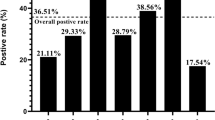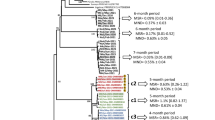Abstract
The objective of this study was to investigate the dynamics and evolution of porcine reproductive and respiratory syndrome virus (PRRSV) ORF5 following the use of a modified live PRRSV (MLV) vaccine. A PRRSV-positive farm with coexistence of types 1 and 2 and no history of MLV vaccination was investigated. Vaccination with a type 2 MLV (Ingelvac PRRS MLV, Boehringer Ingelheim, USA) was implemented. All sows were vaccinated at monthly intervals for two consecutive months and then every third month. Piglets were vaccinated once at 7-10 days of age and weaned to nursery facilities at 21-23 days of age. Serum samples were collected monthly before and after vaccination from four population groups, including replacement gilts and suckling, nursery and finishing pigs, and assayed by PCR. After a year of blood collection, amplified products were sequenced, resulting in 277 complete ORF5 gene sequences from 145 type 1 and 132 type 2 isolates. Prior to and following vaccination, both type 1 and type 2 PRRSV were isolated and found to coexist in an individual pig. Each genotype evolved separately without influencing the strain development of the other. Although the substitution rates of both genotypes were relatively similar, MLV vaccination appears to increase the heterogenicity of type 2 PRRSV, resulting in the emergence of three novel type 2 PRRSV clusters in the herd, including an MLV-like cluster, which disappeared within the month following whole-herd vaccination. Two additional clusters included one related to the MLV vaccine and one related to the endemic cluster of the herd.





Similar content being viewed by others
References
Allende R, Kutish GF, Laegreid W, Lu Z, Lewis TL, Rock DL, Friesen J, Galeota JA, Doster AR, Osorio FA (2000) Mutations in the genome of porcine reproductive and respiratory syndrome virus responsible for the attenuation phenotype. Arch Virol 145:1149–1161
Bassaganya-Riera J, Thacker BJ, Yu S, Strait E, Wannemuehler MJ, Thacker EL (2004) Impact of immunizations with porcine reproductive and respiratory syndrome virus on lymphoproliferative recall responses of CD8(+) T cells. Viral Immunol 17:25–37
Chen N, Cao Z, Yu X, Deng X, Zhao T, Wang L, Liu Q, Li X, Tian K (2011) Emergence of novel European genotype PRRSV in mainland China. J Gen Virol 92:880–892
Conzelmann KK, Visser N, Van Woensel P, Thiel HJ (1993) Molecular characterization of porcine reproductive and respiratory syndrome virus, a member of the arterivirus group. Virology 193:329–339
Drummond AJ, Rambaut A (2007) BEAST: bayesian evolutionary analysis by sampling trees. BMC Evol Biol 7:214
Forsberg R (2005) Divergence time of porcine reproductive and respiratory syndrome virus subtypes. Mol Biol Evol 22:2131–2134
Goldberg TL, Lowe JF, Milburn SM, Firkins LD (2003) Quasispecies variation of porcine reproductive and respiratory syndrome virus during natural infection. Virology 317:197–207
Hesse RA, Couture LP, Lau ML, Wasmoen TL, Doster AR, Cooper VL (1997) Efficacy of PrimePac PRRS in controlling PRRS respiratory disease: homologous and heterologous challenge. In: Proceedings of American association of swine practitioners, pp 137–144
Johnson CR, Griggs TF, Gnanandarajah J, Murtaugh MP (2011) Novel structural protein in porcine reproductive and respiratory syndrome virus encoded by an alternative ORF5 present in all arteriviruses. J Gen Virol 92:1107–1116
Key KF, Haqshenas G, Guenette DK, Swenson SL, Toth TE, Meng XJ (2001) Genetic variation and phylogenetic analyses of the ORF5 gene of acute porcine reproductive and respiratory syndrome virus isolates. Vet Microbiol 83:249–263
Kim HK, Park SJ, Rho SM, Han JY, Nguyen VG, Park BK (2011) One year’s study of dynamic and evolution of types I and II PRRSV in a swine farm. Vet Microbiol 150:230–238
Kim SH, Roh IS, Choi EJ, Lee C, Lee CH, Lee KH, Lee KK, Song YK, Lee OS, Park CK (2010) A molecular analysis of European porcine reproductive and respiratory syndrome virus isolated in South Korea. Vet Microbiol 143:394–400
Kosakovsky Pond SL, Posada D, Gravenor MB, Woelk CH, Frost SD (2006) GARD: a genetic algorithm for recombination detection. Bioinformatics 22:3096–3098
Lager KM, Mengeling WL, Brockmeier SL (1997) Homologous challenge of porcine reproductive and respiratory syndrome virus immunity in pregnant swine. Vet Microbiol 58:113–125
Lee C, Kim H, Kang B, Yeom M, Han S, Moon H, Park S, Song D, Park B (2010) Prevalence and phylogenetic analysis of the isolated type I porcine reproductive and respiratory syndrome virus from 2007 to 2008 in Korea. Virus Genes 40:225–230
Martin DP, Williamson C, Posada D (2005) RDP2: recombination detection and analysis from sequence alignments. Bioinformatics 21:260–262
Meulenberg JJ, Petersen den Besten A, de Kluyver E, van Nieuwstadt A, Wensvoort G, Moormann RJ (1997) Molecular characterization of Lelystad virus. Vet Microbiol 55:197–202
Nelsen CJ, Murtaugh MP, Faaberg KS (1999) Porcine reproductive and respiratory syndrome virus comparison: divergent evolution on two continents. J Virol 73:270–280
Nilubol D, Tripipat T, Hoonsuwan T, Tipsombatboon P, Piriyapongsa J (2013) Genetic diversity of the ORF5 gene of porcine reproductive and respiratory syndrome virus (PRRSV) genotypes I and II in Thailand. Arch Virol 158:943–953
Opriessnig T, Halbur PG, Yoon KJ, Pogranichniy RM, Harmon KM, Evans R, Key KF, Pallares FJ, Thomas P, Meng XJ (2002) Comparison of molecular and biological characteristics of a modified live porcine reproductive and respiratory syndrome virus (PRRSV) vaccine (ingelvac PRRS MLV), the parent strain of the vaccine (ATCC VR2332), ATCC VR2385, and two recent field isolates of PRRSV. J Virol 76:11837–11844
Ostrowski M, Galeota JA, Jar AM, Platt KB, Osorio FA, Lopez OJ (2002) Identification of neutralizing and nonneutralizing epitopes in the porcine reproductive and respiratory syndrome virus GP5 ectodomain. J Virol 76:4241–4250
Plagemann PG, Rowland RR, Faaberg KS (2002) The primary neutralization epitope of porcine respiratory and reproductive syndrome virus strain VR-2332 is located in the middle of the GP5 ectodomain. Arch Virol 147:2327–2347
Plagemann PG (2004) GP5 ectodomain epitope of porcine reproductive and respiratory syndrome virus, strain Lelystad virus. Virus Res 102:225–230
Song J, Shen D, Cui J, Zhao B (2010) Accelerated evolution of PRRSV during recent outbreaks in China. Virus Genes 41:241–245
Tamura K, Dudley J, Nei M, Kumar S (2007) MEGA4: molecular evolutionary genetics analysis (MEGA) software version 4.0. Mol Biol Evol 24:1596–1599
Thanawongnuwech R, Amonsin A, Tatsanakit A, Damrongwatanapokin S (2004) Genetics and geographical variation of porcine reproductive and respiratory syndrome virus (PRRSV) in Thailand. Vet Microbiol 101:9–21
Thompson JD, Higgins DG, Gibson TJ (1994) CLUSTAL W: improving the sensitivity of progressive multiple sequence alignment through sequence weighting, position-specific gap penalties and weight matrix choice. Nucleic Acids Res 22:4673–4680
Tun HM, Shi M, Wong CL, Ayudhya SN, Amonsin A, Thanawonguwech R, Leung FC (2011) Genetic diversity and multiple introductions of porcine reproductive and respiratory syndrome viruses in Thailand. Virol J 8:164
Wu WH, Fang Y, Farwell R, Steffen-Bien M, Rowland RR, Christopher-Hennings J, Nelson EA (2001) A 10-kDa structural protein of porcine reproductive and respiratory syndrome virus encoded by ORF2b. Virology 287:183–191
Acknowledgments
The authors are grateful to the Thailand Research Fund (Project Number MRG5080323 and IUG5080001) and the Government budget years 2008 and 2012 for funding this research.
Author information
Authors and Affiliations
Corresponding author
Electronic supplementary material
Below is the link to the electronic supplementary material.
Rights and permissions
About this article
Cite this article
Nilubol, D., Tripipat, T., Hoonsuwan, T. et al. Dynamics and evolution of porcine reproductive and respiratory syndrome virus (PRRSV) ORF5 following modified live PRRSV vaccination in a PRRSV-infected herd. Arch Virol 159, 17–27 (2014). https://doi.org/10.1007/s00705-013-1781-9
Received:
Accepted:
Published:
Issue Date:
DOI: https://doi.org/10.1007/s00705-013-1781-9




